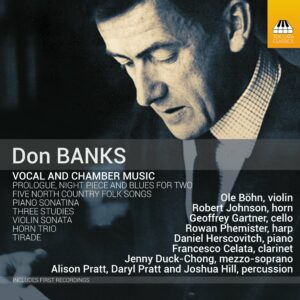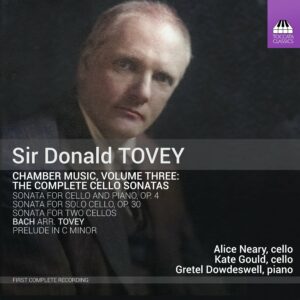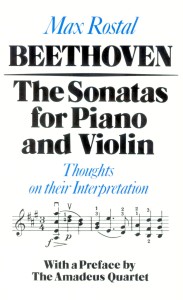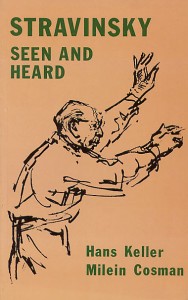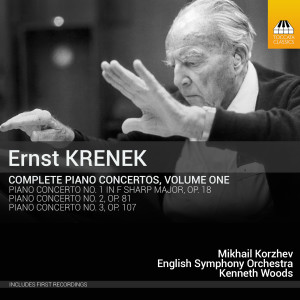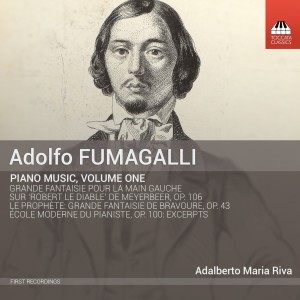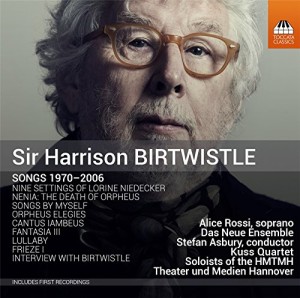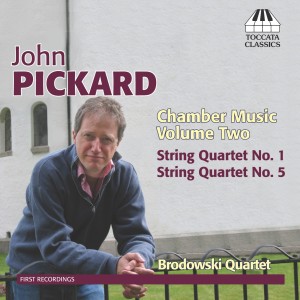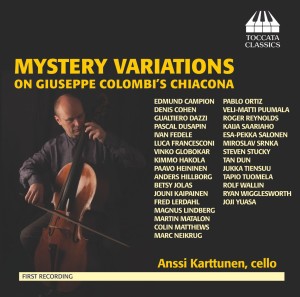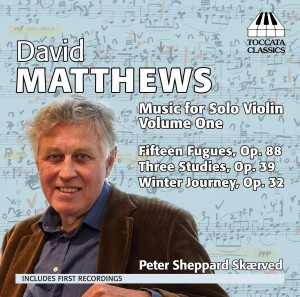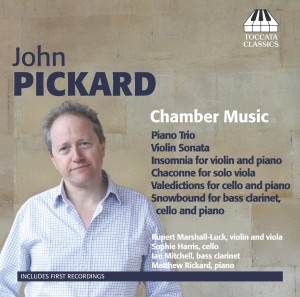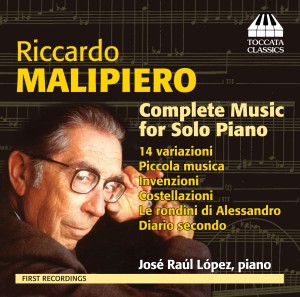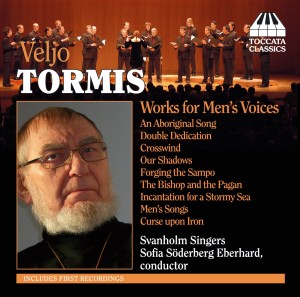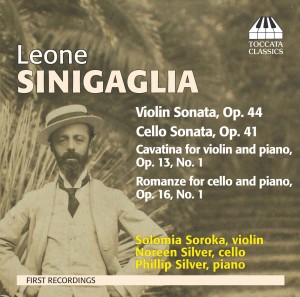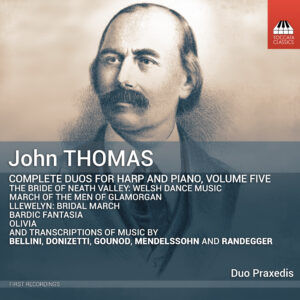Search Results for "MrWhosetheboss 5 Tech Products changed life video description site:youtube.com"
Don Banks: Vocal and Chamber Music
During his short life Don Banks (1923–80) enjoyed a reputation as the leading modernist among Australian composers. Studies with Mátyás Seiber, Milton Babbitt and, especially, Luigi Dallapiccola helped refine his serial technique, but his music never retreated into academic abstraction, as this recital of chamber and vocal works demonstrates: it retained a keen sense of drama, an ear for atmosphere, a rather angular lyricism and, occasionally, a touch of humour.
Robert Johnson, horn (Tracks 1–3)
Ole Böhn, violin (Tracks 1–3, 18)
Jenny Duck-Chong, mezzo-soprano (Tracks 4–8, 19–21)
Francesco Celata, clarinet (Tracks 9–11)
Geoffrey Gartner, cello (Tracks 12–14)
Rowan Phemister, harp (Tracks 19–21)
David Kim-Boyle, siren (Track 21)
Alison Pratt, Daryl Pratt and Joshua Hill, percussion (Tracks 19–21)
Daniel Herscovitch, piano
Sir Donald Tovey: Chamber Music, Volume Three: The Complete Cello Sonatas
Sir Donald Tovey (1875–1940), long hailed as one of the finest writers on music in English, saw himself primarily as a composer. His occasionally turbulent friendship with Pau Casals was the spur for a monumental concerto and one of his three cello sonatas: for solo cello, two cellos and cello with piano. The cello was the ideal instrument for Tovey’s Brahmsian musical language, with its long, singing lines unfolding in effortless counterpoint – though the huge passacaglia that ends the solo sonata also demands a virtuoso technique. The brief Bach arrangement recorded here for the first time arose when the twelve-year-old Tovey added a cello line to one of Bach’s best-known preludes, originally for lute.
Alice Neary, cello
Kate Gould, cello (Tracks 1–3)
Gretel Dowdeswell, piano (Tracks 4, 8–10)
Beethoven: The Sonatas for Piano and Violin: Thoughts on their Interpretation
With a Preface by The Amadeus Quartet, a Postscript by Günter Ludwig, and an Appendix by Paul Rolland Translated by Horace and Anna Rosenberg
Extent: 219 pages
Composition: Demy octavo ~ Illustrated ~ Bibliography ~ Index
Stravinsky Seen and Heard
Superseded by Stravinsky the Music-Maker
Extent: 128 pages
Composition: Demy octavo ~ Illustrated ~ Index
Ernst KRENEK: Complete Piano Concertos, Volume One
The piano concertos of Ernst Krenek (1900–91) are major contributions to the twentieth-century repertoire, comparable to those of Bartók, Prokofiev, Schoenberg and Shostakovich, but astonishingly two of them have never had commercial recordings – an omission this series seeks to redress. Piano Concertos Nos. 1–3, written between 1923 and 1946, show Krenek throwing off the constraints of tonality in favour of a freewheeling, individual use of twelve-tone technique, brimming with colour and often animated with a keen sense of wit.
Mikhail Korzhev
English Symphony Orchestra
Kenneth Woods
Adolfo Fumagalli: Piano Music, Volume One
In his brief life Adolfo Fumagalli (1828–56), one of four musician brothers from Inzago, near Milan, made a name for himself across Europe as ‘the Paganini of the piano’, astonishing audiences with his dazzling technique and acquiring an especial reputation for performances using his left hand alone. Fumagalli composed a large body of piano music – over 100 opus numbers – many of them operatic fantasies and virtuosic studies of the type presented in this anniversary recital, recorded in his home town.
Adalberto Maria Riva, piano
Sir Harrison Birtwistle: Songs 1970-2006
Instrumental and vocal techniques are intertwined in the music of Harrison Birtwistle: he often treats the voice instrumentally and his instrumental writing has vocal characteristics. Many of his works for small ensembles, with or without voices, occupy this common ground, his highly individual style juxtaposing the static and the violently dynamic and intersecting with his fondness for ritual and myth – not least a recurrent concern with the figure of Orpheus. This recording presents some of these relatively neglected pieces, recorded live in the presence of the composer, who also talks about his songs in interview.
John Pickard: Chamber Music Volume Two
Reviews of music by the English composer John Pickard (b. 1963) have stated that 'he has the technique and the temperament to emerge as one of the great symphonists of the 21st century', even that 'his place among the greats is secure'. The earliest and most recent of his five string quartets — neither previously recorded — date from two decades apart but show the same masterly control of counterpoint and an overarching sense of harmonic direction. The First (1991) is cast in a huge single paragraph, 38 minutes in length, unfolding with the drama and pace of an adventure novel; the five-movement Fifth (2012-13) explores a dialectic of conflict and resolution.
Brodowski Quartet, string quartet
Mystery Variations on Giuseppe Colombi’s Chiacona
To celebrate the 50th birthday of the Finnish cellist Anssi Karttunen in 2010 his wife, Muriel von Braun, and colleague and countrywoman Kaija Saariaho wrote to a number of composers with whose music Karttunen had been working, asking each to write a variation on the Chiacona per basso solo by the Italian composer Giuseppe Colombi (1635-94) — perhaps the earliest work in the history of the cello. The composers were not told who else was involved in the project, and Karttunen agreed to perform the music before he had seen it — hence the title, Mystery Variations. These 31 variations thus link the very beginning of the cello repertoire with music by some of the most distinguished composers of the present day and, with their distant echo of Beethoven's 32 'Diabelli' Variations, provide a showcase for the extraordinary resourcefulness of contemporary cello technique.
Anssi Karttunen, cello
David Matthews: Music for Solo Violin, Volume One
David Matthews' Fifteen Fugues for solo violin, composed over four years between 1998 and 2002, not only constitute what is probably the largest set of violin fugues by a living composer; they also form an extended essay in musical portraiture, with each fugue 'depicting' its dedicatee. Like the Three Studies (1985) and Winter Journey (1982-83), a tone-poem for solo violin inspired by Schubert's Winterreise, they pose extraordinary technical challenges to the performer.
Peter Sheppard Skærved, violin
John Pickard: Chamber Music
Reviews of music by the English composer John Pickard (b. 1963) have stated that 'he has the technique and the temperament to emerge as one of the great symphonists of the 21st century', even that 'his place among the greats is secure'. This conspectus of his chamber music traces the evolution of his style over two decades, from the Piano Trio of 1990 to Snowbound of 2010, revealing a powerful rhythmic drive, a feeling for toughly argued drama and a poetic sensitivity to atmosphere among its most prominent characteristics.
Rupert Marshall-Luck, violin, viola
Sophie Harris, cello
Ian Mitchell, bass clarinet
Matthew Rickard, piano
Riccardo Malipiero: Complete Music for Solo Piano
The Italian composer Riccardo Malipiero (1914-2003), nephew of the better-known Gian Francesco Malipiero, was one of the pioneers of twelve-tone technique in Italy. His six published piano works — recorded here for the first time — encapsulate half-a-century of development, from the post-Respighian 14 variazioni of 1938, via the Bachian Invenzioni and the virtuosic Costellazioni, to the classicism of the Diario second of 1985. But Malipiero's concern was more with individuality of expression than with modernist dogma, and he was happy to break the rules in pursuit of colour and variety.
José Raúl López, piano
Veljo Tormis: Works for Men’s Voices
The Estonian composer Veljo Tormis (born in 1930) has carved a unique position for himself in contemporary music. By marrying the quasi-minimalist rhythmic vigour of Estonian runic singing – a tradition some 3,000 years old – with the extended techniques of modern choral writing, he has created a body of music tingling with excitement, energy and power. Many of the works on this CD – where the composer, playing shaman drum and anvil, joins one of Scandinavia’s brightest young choirs – draw on folk sources in a reaffirmation of Estonian identity; others evoke the forces of nature as a metaphor for political upheaval.
Svanholm Singers, choir
Sofia Söderberg Eberhard, conductor
John Gardner: Complete Organ Music, Volume Two
The English composer John Gardner (1917–2011) played the organ from an early age; his first work to be published was for the organ, and he wrote for the instrument throughout his long life. His music, whether secular or sacred, is characterised by a rhythmic vivacity and technical command informed by his fondness for jazz, Renaissance and Baroque procedures and classical counterpoint – and the spirit of dance is often close to hand. Its quirky and distinctive personality is a mirror of the man: Gardner’s gruff, slightly formal manner barely hid a mischievous sense of humour, flashes of which can be glimpsed even in his more serious works. Above all, his musical language is honest and emotionally direct, as he was.
Tom Winpenny, organ of Christchurch Priory
Leone Sinigaglia: Chamber Music
Leone Sinigaglia, born in Turin in 1868, was a friend of Brahms in Vienna and a student of Dvořák in Prague, applying their classical techniques to the inspiration he found in Italian folksong: his music is marked by strong melodies and a sophisticated use of harmony. Championed by musicians of the standing of Barbirolli, Furtwängler, Kreisler, Stokowski and Toscanini, he was also a famous mountaineer, with two first climbs in the Dolomites to his credit. Sinigaglia, who was Jewish, died in Turin in 1944 as he was being arrested, at the age of 75, by the occupying Nazi forces. His tuneful chamber music bears witness to the happy life that preceded that tragic end.
Solomia Soroka, violin
Noreen Silver, cello
Phillip Silver, piano
John Thomas: Complete Duos for Harp and Piano, Volume Five
The Welshman John Thomas (1826–1913), harpist to Queen Victoria, wrote prolifically for his own instrument, both for solo harp and for duos of two harps or harp and piano – a combination where the different sounds of the two instruments enhance the clarity of the texture. Thomas’ original works use the elegant Romantic style of his own day, but he often drew on Welsh folksong for his inspiration and left a generous legacy of transcriptions, especially of operatic favourites. Although some of his music was intended for the Victorian drawing room, other pieces require a virtuoso technique – and all of it has a thoroughly engaging melodic appeal. This fifth album of his duets for harp and piano ends a series that has seen the revival of music unheard for over a century and a half.
Duo Praxedis
Praxedis Hug-Rütti, harp
Praxedis Geneviève Hug, piano
Stay In the Know
JOIN THE TOCCATA NEWSLETTER
"*" indicates required fields
By visiting our site, you agree to our privacy policy regarding cookies, tracking statistics, etc.
